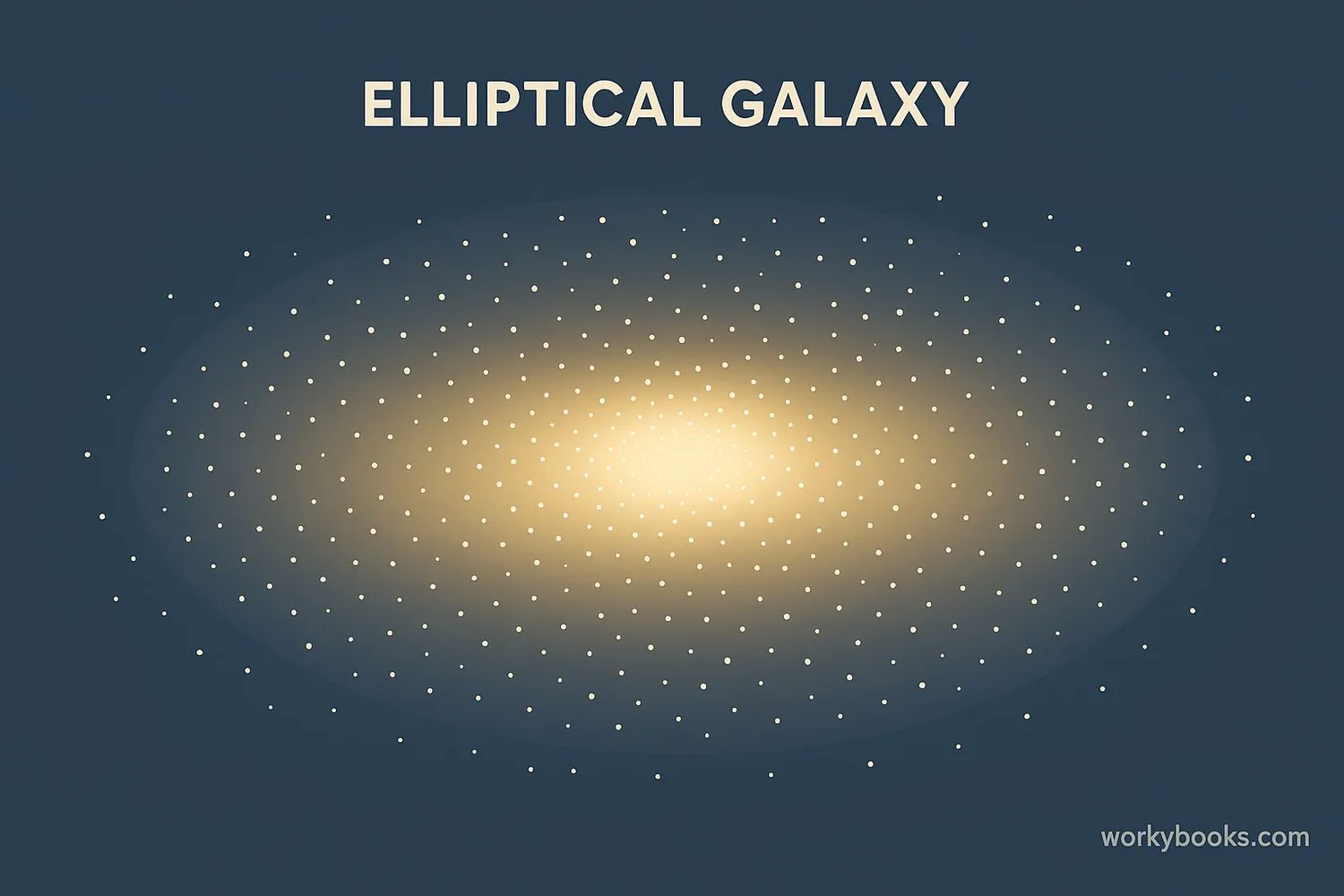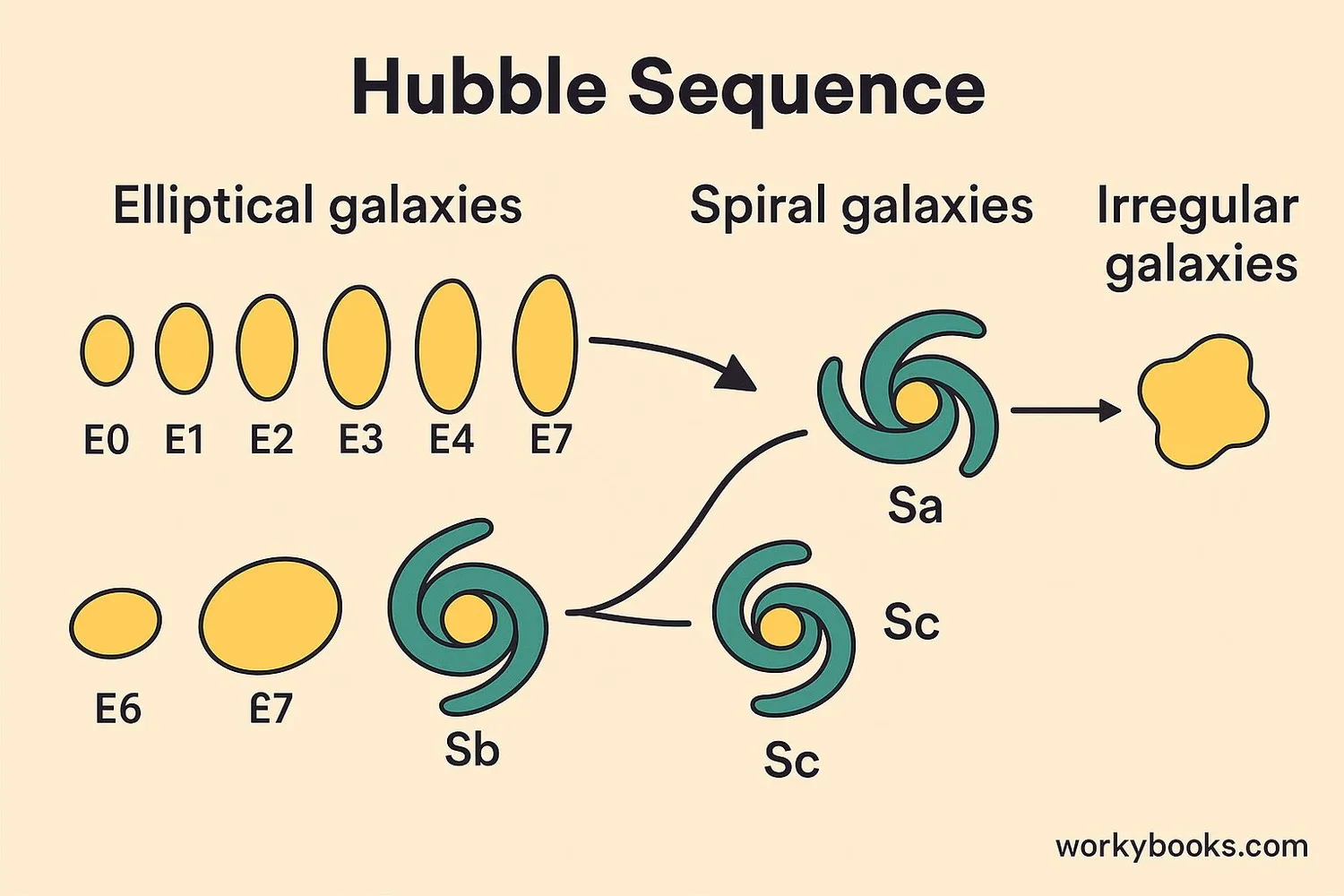Elliptical Galaxies - Definition, Examples, Quiz, FAQ, Trivia
Discover the cosmic giants of our universe
What Are Elliptical Galaxies?

Elliptical galaxies are one of the main types of galaxies in our universe. Unlike spiral galaxies (like our Milky Way) with their beautiful arms, elliptical galaxies are shaped like flattened balls or ovals.
These galaxies are made up of billions of stars but contain very little gas and dust. Because of this, elliptical galaxies don't form many new stars. Instead, they're filled with older, redder stars that give them a reddish appearance - astronomers sometimes call them "red and dead" galaxies.
Elliptical galaxies come in different sizes, from small dwarf elliptical galaxies with just a few million stars to enormous supergiant elliptical galaxies that can be 10 times larger than our Milky Way!
Galaxy Fact!
The largest known galaxy, IC 1101, is an elliptical galaxy that contains about 100 trillion stars!
How Elliptical Galaxies Form

Scientists believe that most elliptical galaxies form through galactic collisions. When two spiral galaxies collide and merge, their gas and dust get used up in massive bursts of star formation. The remaining stars settle into random orbits, creating the smooth, oval shape of an elliptical galaxy.
This process can take billions of years. The collision destroys the beautiful spiral arms and creates a galaxy that looks like a giant cosmic football. The stars in elliptical galaxies move in all different directions rather than rotating together like in spiral galaxies.
Galaxies Approach
Two spiral galaxies move toward each other
Collision
Galaxies collide and their shapes distort
Merger
Galaxies merge into a single chaotic mass
Settling
Stars settle into elliptical orbits
Elliptical Galaxy
A new elliptical galaxy is formed
Galactic Recycling
Our own Milky Way galaxy is on a collision course with the Andromeda galaxy! In about 4.5 billion years, they will collide and likely form a new elliptical galaxy.
Types and Classification

Astronomers classify elliptical galaxies using the Hubble sequence developed by Edwin Hubble. Elliptical galaxies are labeled with the letter "E" followed by a number from 0 to 7. The number tells us how oval-shaped the galaxy is:
E0 (Round)
E3
E5
E7 (Most oval)
Size classifications:
• Supergiant ellipticals: The largest galaxies, found at galaxy cluster centers
• Giant ellipticals: Common in galaxy clusters
• Dwarf ellipticals: Small galaxies with just a few million stars
Famous Example: M87
The M87 galaxy is a supergiant elliptical galaxy with a supermassive black hole at its center. This black hole was the first ever to be directly imaged by astronomers!
Why Elliptical Galaxies Matter

Elliptical galaxies play a crucial role in our understanding of the universe:
Cosmic History
They contain some of the oldest stars in the universe
Galaxy Evolution
Show us how galaxies change over billions of years
Black Hole Research
Often host supermassive black holes at their centers
Elliptical galaxies are important because:
• They show us what happens when galaxies collide
• They contain clues about the early universe
• They dominate the centers of galaxy clusters
• Their supermassive black holes affect galaxy evolution
By studying elliptical galaxies, astronomers learn about the life cycles of galaxies and the history of our universe.
Galaxy Quiz
Test your knowledge about elliptical galaxies with this quiz!
Frequently Asked Questions
Here are answers to common questions about elliptical galaxies:
Space Trivia
Discover amazing facts about elliptical galaxies:
Cosmic Giants
The largest known galaxy is IC 1101, a supergiant elliptical galaxy. If placed in our solar system, it would extend halfway to the nearest star!
Massive Centers
The elliptical galaxy M87 contains a supermassive black hole that weighs 6.5 billion times more than our sun. We have an actual image of this black hole!
Ancient Stars
Elliptical galaxies contain some of the oldest stars in the universe, with many being over 10 billion years old. That's more than twice as old as our sun!
Cluster Dominance
In large galaxy clusters, up to 80% of the brightest galaxies are elliptical. They tend to gather at the very centers of these clusters.


